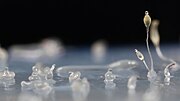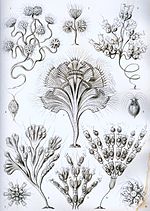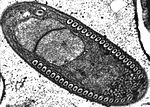The Archamoebae are a group of protists originally thought to have evolved before the acquisition of mitochondria by eukaryotes. They include genera that...
8 KB (732 words) - 23:08, 10 December 2023
structures except during mitosis. However, flagella do occur among the Archamoebae, and many slime moulds produce biflagellate gametes [citation needed]...
45 KB (4,020 words) - 02:13, 5 June 2024
"primitive" amitochondriate amoeboids in a new taxonomical group: the Archamoebae. The Archamoebae were, in turn, recruited to the new kingdom of Archezoa, along...
8 KB (1,344 words) - 11:15, 11 February 2024
infraphyla: Archamoebae and Mycetozoa. Notable characteristics of these two groups are that Mycetozoa are free living, while Archamoebae are amitochondrial...
9 KB (820 words) - 22:15, 13 March 2024
(F), ebriids (F) Amoebozoa: Multicilia (F), phalansteriids (F), some archamoebae (F/S) Opisthokonta: choanoflagellates (F) Excavata Discoba: jakobids...
13 KB (1,350 words) - 03:43, 17 June 2024
amoebozoans: Eumycetozoa or "true" slime molds, Variosea, Cutosea and Archamoebae. It is defined on a node-based approach as the least-inclusive clade...
9 KB (814 words) - 06:06, 28 June 2024
Mucoromycotina Zoopagomycotina Amoebozoa Conosa Mycetozoa (slime-molds) Archamoebae Lobosa Protamoebae Bikonta Apusozoa Excavata Archaeplastida (plants,...
11 KB (767 words) - 16:50, 20 July 2024
mitochondria or derived structures: The microsporidians, metamonads, and archamoebae. These groups appear as the most primitive eukaryotes on phylogenetic...
166 KB (18,360 words) - 05:40, 16 July 2024
infraphylum Semiconosia (Mycetozoa and Variosea) and secondarily anaerobic Archamoebae. Lobosa consists entirely of non-flagellated lobose amoebae and has been...
9 KB (1,112 words) - 16:46, 18 June 2024
Subphylum Lobosa Subphylum Conosa Infraphylum Archamoebae Infraphylum Mycetozoa Superclass Eumyxa Superclass...
74 KB (4,819 words) - 10:13, 22 July 2024
has been consistently recovered as the sister group to Archamoebae. The Eumycetozoa+Archamoebae clade is, in turn, the sister group to Variosea. Within...
15 KB (1,509 words) - 07:02, 8 April 2024
Mastigamoeba is a genus of pelobionts, and treated by some as members of the Archamoebae group of protists. Mastigamoeba are characterized as anaerobic, amitochondriate...
15 KB (1,788 words) - 06:01, 16 May 2024
Arcellinida. Other non-fruiting amoebozoans are Variosea, Discosea and Archamoebae. Obazoa includes the two kingdoms Metazoa (animals) and Fungi, and their...
94 KB (9,770 words) - 21:18, 25 June 2024
‘Mastigamoeba invertens’. This organism, initially classified in the Archamoebae within phylum Amoebozoa, appeared to strongly diverge in phylogenetic...
10 KB (827 words) - 16:10, 22 September 2023
Scientific classification Domain: Eukaryota Phylum: Amoebozoa Class: Archamoebae Order: Amoebida Genus: Entamoeba Species: E. invadens Binomial name Entamoeba...
13 KB (1,665 words) - 13:43, 15 April 2024
Entamoebidae is a family of Archamoebae. It includes Entamoeba and Entamoebites. "www.ncbi.nlm.nih.gov". Retrieved 2009-05-06. v t e...
813 bytes (23 words) - 21:54, 28 April 2021
characteristics help in species identification. Entamoeba belongs to the Archamoebae, which like many other anaerobic eukaryotes have reduced mitochondria...
14 KB (1,482 words) - 20:12, 16 October 2023
amoeboflagellates in various stages of their life cycle. Many species of Archamoebae, a more basal group, are anaerobic amoeboflagellates. Other examples...
5 KB (1,167 words) - 14:50, 20 May 2024
along with the other Protozoa such as diplomonads, parabasalids and archamoebae in the protozoan-group Archezoa. More recent research has falsified this...
41 KB (2,893 words) - 13:05, 29 March 2024
evidence. Revue de Micropalêontologie 33:145–154. Cavalier Smith, T. 1991. Archamoebae: the ancestral eukaryotes? Biosystems 25:25–38. Cavalier Smith, T. ....
37 KB (3,540 words) - 20:00, 12 May 2024
Oligohymenophorea Order: Peniculida Paramecium sp. Phylum: Amoebozoa Class: Archamoebae Order: Pelobiontida Pelomyxa quarta Phylum: Myzozoa Class: Dinophyceae...
13 KB (1,182 words) - 21:20, 16 March 2024
mold, which has been studied for centuries; other members include the Archamoebae, Tubulinea and Flabellinia. Some Amoeboza cause disease. The Chromista...
54 KB (2,451 words) - 06:34, 6 January 2024
Scientific classification Domain: Eukaryota Phylum: Amoebozoa Class: Archamoebae Family: Entamoebidae Genus: Endamoeba J. Leidy, 1879 Type species Endamoeba...
2 KB (78 words) - 09:09, 9 February 2024
Scientific classification Domain: Eukaryota (unranked): Amoebozoa Class: Archamoebae Order: Mastigamoebida Family: Mastigamoebidae Genus: Mastigella Johannes...
786 bytes (25 words) - 19:41, 23 March 2021














